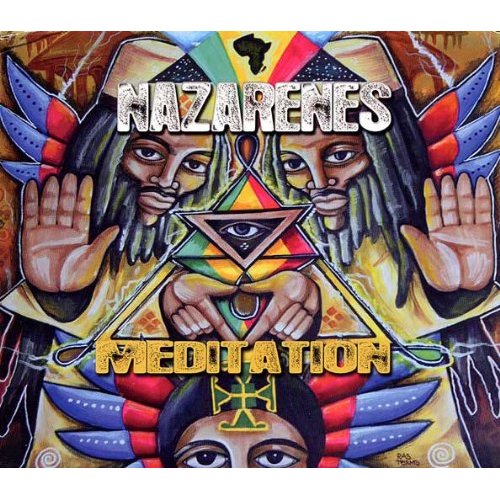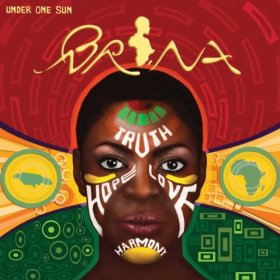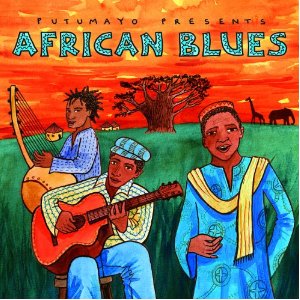 Clinton Fearon: Mi an Mi Guitar, Boogie Brown Productions, 2005
Clinton Fearon: Mi an Mi Guitar, Boogie Brown Productions, 2005
Rating: A
Listening to Mi an Mi Guitar, I thought of Pablo Picasso. Yes, the late painter Picasso, the one whose name is synonymous with modern art. Towards the end of his long career, his output included some of the most simple and basic works he had ever done. It was his mi an mi paint and mi an mi ink time. His paintings became rudimentary exercises in form and color. His drawings became frugal; they were simple ideas rendered in the simplest of lines. These were works you might consider unsophisticated, perhaps even primitive.
Or as many art lovers do, you could consider them close to the ultimate in sophistication, the purest form of the masters art, the distillation of his craft. He had proved himself long before, and now had no need to impress, only to create. How you respond to the results of that confidence depends in part on your value system, and that will likely help determine how much you enjoy this unique album by reggae veteran Clinton Fearon.
The title tells the tale: what you get on this disc is human voice and acoustic guitarand, of course, a handful of melodic, contemplative songs. No drums, bass, keyboards, horns, synthesizers, harmony trios or studio trickery. What is reggae without drum and bass? What is contemporary reggae without big production? How engaging can something be when there is so little involved?
For the answers you may just have to buy this album. You will discover (or reconfirm) that art can be an unadorned, uncomplicated, highly personal thing. You will know that the worth of music is not measured in decibels. You will learn that reggaes rhythms are as much in the mind as in the speakers. Above all, you will notice that when an old friend visits and hauls out his guitar and starts singing a simple song he wrote, thats one of those times when life seems at its fullest.
 Various: The Bunny Lee Rocksteady Years, Moll-Selekta, 2005
Various: The Bunny Lee Rocksteady Years, Moll-Selekta, 2005
Rating: B+
Some albums are easier to listen to than they are to review. What can I say about a various artists compilation entitled The Bunny Lee Rocksteady Years that you havent already figured out, just from reading this far? The title gives away the producer, the genre and the modus operandi of the whole album.
By no means does the lack of surprise (and the difficulty in reviewing) end there. If you are a fan of early reggae, you will be able to guess most of the artists, and if you are not a fan, their names really wont matter. If you have other Moll-Selekta albums, you will be familiar with the labels comprehensive liner notes, almost impeccable track selection and attractive, high quality fold-out packaging (except this time the cover photo is digitally stretched, always a lousy idea). Finally, if you are at all acquainted with the rocksteady era of Jamaican music, you know the music will be comprised primarily of short, melodic love songs, soulfully delivered over a sturdy foundation of drums and animated bass guitar.
Well then, what wouldnt you know? Heres one thing: given that the Jamaican studios of the time (1967-68) were very busy places, and that Lees hit-filled output as producer was typically prolific, even a rabid fan could not anticipate some of the songs that surface on this disc. Although listing artists and titles is a publicists job, not a reviewers, I can reveal that among the generous selection of 25 tracks, some are rare enough that even most fanatics wont already have them in their collection, including songs from Alva Lewis, Cynthia Richards, and Webber Sisters. Dawn Penns Long Day Short Night seems out of place, being more ska than rocksteady, but I heartily commend the inclusion of four songs by The Sensations, smooth pre-cursors of the great harmony trios of the roots reggae era. Closing with the sole instrumental is a nice idea too.
No, there arent many surprises involved in this album, but there are pleasures galore. If you enjoy relaxing reggae rhythms, beautiful vocals and sweet tunes, I recommend you get this album. No surprise there either.
 Kasumai: Senegal: urban rhythms, ARC Music, 2005
Kasumai: Senegal: urban rhythms, ARC Music, 2005
Rating: B
When you look at the track list and see song titles like Diambadon (Leaf Dance) and Kassak (Initiation to Circumcision), youre going to think, Ah yes, traditional album. I know the type. And if you then listen to Kassak, with its almost primordial drumming and chanting, youll be convinced you were right. But. If you hadnt noticed the titles and your laser beam happened to land first on the full but muted arrangement and Latin melody of track 3, you might very well think, Ah yes, sophisticated contemporary Cuban album. I know the type.
Fact is, Senegal: urban rhythms is a marriage of the traditional and the contemporary, and a very successful union at that. Different elements cooperatively exist side by side. Traditional drums and a drum kit. Kora and keyboards. Ancient melodies and electric guitar. It may not come as a surprise to learn that two Kasumai group members, including song writer Sagar NGom, were involved with Outback (later Baka Beyond) for several albums. Nor is it a surprise after a bit of listening to read that the group admires (and was influenced by) earlier Senegalese groups like Orchestra Baobab and Tour Kunda, and by fellow countryman Baaba Maal.
Some favorite tracks:
Alla Lamina with rippling kora so complex its hard to believe its a solo.
Mado, a heartfelt tribute by the vocalist to his wife who had recently died after childbirth.
Diambadon with its emphatic percussion, abrupt changes and call and response vocals.
Le Travail for the furious pace and beautiful instrumental interplay.
Equipe National, a message to soccer hooligans everywhere that there is a better approach to cheering for ones team, namely the cascading sound of the kora and lyrics that link the process of preparing to catch fish to the national team preparing for a game.
Anniversaire, a restrained, gentle effort that borrows a riff from the classic Latin melody Guantamara.
Casa NCol for its vocal intro and very intense sound.
Yikes, thats half the album on my favorites list. But the booklet accompanying the CD is praiseworthy too. It includes an essay on the group itself, bios and photos of its members, descriptions of the traditional instruments used, and summaries of the song lyrics, all in several languages. Plus, in English, the recording credits. Its a perfect addition to a varied, accessible, enjoyable album.
 Dub Gabriel: Bass Jihad, Azra Records, 2005
Dub Gabriel: Bass Jihad, Azra Records, 2005
Rating: A
I should not like this as much as I do. My love of interesting sounds is usually tempered by a distaste for noisy or droning sounds. This has some of all three, but the interesting parts prevail, and as I have to admit, its all musical. Maybe it was the warm, handsome, intriguing packaging that seduced me; it might have put me in such a great mood that I was ready to accept whatever came from the speakers.
What does come from the speakers is as intriguing as the package. Here we have someone, Dub Gabriel by name, who takes delight in exploring his musical ideas at length and concerns himself more with texture, contrast and rhythm than with melody. So this is not dub reggae; this is dubbish musical adventure informed by reggae.
Okay, but you still want to know what Bass Jihad sounds like. Given the title you expect a swirling, percussive Near East flavor to dominate, which at times is true; in fact the first track delivers exactly that. But the next one plunks us suddenly into an elevator shaft connected to a busy factory floor where the workers clang in rhythm as the foreman drones commands, while nearby some women endlessly practice one segment of one bar of a choral arrangement. Thats what I hear, anyway, and I like it.
Skipping several tracks, we encounter what might be a sitar player riffing away during a party, a womans not-quite-laugh intruding from the next room as an orchestra proceeds through its pre-concert tuning routine. Later a church organ competes with an airport next door and a rock drummer in the basement. A lighter tone follows, a tapped rhythm accompanying a keyboardist practicing a bird call in a Greek caf with Augustus Pablo on the jukebox. The disc ends with 16 minutes of slowly building sound effects, deep bass, deep chanting, Arabic musical structure, and East Indian percussion to a Nyahbinghi rhythm.
With its creative voice sampling, its smart rhythms, its ambiance by turns claustrophobic and spacey, and its complex musical character, Bass Jihad lends itself to a state of wonderment: what in the world is going on? As you can tell, the answer is definitely not easy, but the challenge it presents to the imagination is thoroughly enjoyable.
 Audrey Gordon: Still Waiting, 2004
Audrey Gordon: Still Waiting, 2004
Rating: B
Did you realize there are degrees of righteousness? Audrey Gordons motto is Pursuing Excellence in Righteousness. Problem is, if theres an excellent kind, there must be a humdrum kind too, and even a downright miserable version of righteousness grovelling in the dirt somewhere. Finding that concept hard to grasp, I began to wonder if self-righteousness may be the real issue, so I feared the worst when I put Still Waiting into my disc player.
What a relief. Neither in her lyrics nor in her delivery does Gordon come across as a self-righteous dogmatist. She presents herself convincingly as a humble believer, true to her Christian faith and eager to praise. She is witnessing, not proselytizing.
Fortunately, witnessing of this kind is very easy to take, because Gordon writes songs exceptionally well, sings pretty well most of the time, and associates with an uncredited but terrific bunch of reggae musicians. Yes, this is Christian reggae (plus one soca track), not much different as a genre from the Rastafarian kind except in certain details of the lyrics. Therefore do not expect the powerful, shake-the-church-rafters gospel shouting of Clara Wards heyday. These vocals are lively but not dramatic; sincere rather than lambasting.
We get lots of sparkling rhythms and memorable, catchy tunes, so many that a list of my favorites would include half the album. Its easier to pick the four tracks (of 17) that arent great, where Gordons voice sounds strained and somewhat off pitch; she has a real problem dealing with the changes of Blood Medley, for example. Maybe she was tired that day. Otherwise she is in fine form, including a toast to her own singing vocal. The disc ends touchingly, her spoken voice reciting verses from Psalm 8 over a reprise of one of her best songs.
I dont know about her aspirations to righteous excellence, but Audrey Gordon has certainly achieved a high degree of musical excellence in most of this album. And to be blunt, for us listeners thats the more important goal.
 Steele: Uncorrupted Steele, Mobs, 2004
Steele: Uncorrupted Steele, Mobs, 2004
Rating: B
To get an accurate idea of what Uncorrupted Steele sounds like, you would have to look at the photo on the back cover as well as the front. The singer/songwriters meditative, sensitive, introspective side is illustrated in the front cover portrait, but the back is where the action is. It portrays an outgoing, happy Steele, confident and animated, and for me that is the portrait of the artist that lingers when the album ends.
After a short spoken intro, Steele launches into a highly positive sort of reggae dancehall, in which he declares, Greetings in the name of the King/I will keep on smiling cause His Majesty lives within. You see? Right off the bat the moody, pensive image of the cover is deflated. The track also sets a high musical standard for what is to come. Fortunately, what follows is up to that standard: a catchy tune, strong rhythm, soulful vocal and lyrics that slide a few comments about social conditions into his Rastafarian moralizing.
In fact, the standard is never lowered, even though Steele eventually veers in other directions: a love song where he is trying to get back on his girls good side, then a heartfelt and pretty hymn (Even the roughest among us need a little bit of prayer sometimes.) Next comes a familiar musical quote: If I am guilty I will pay, which launches us into a quick-stepping, synthesized rhythm and interesting arrangement for lyrics that demand justice. The albums highlight has to be Ruben, a complex piece with strong ragga rhythm. Steele exerts remarkable vocal control over some very abrupt changes, but what makes it especially engaging is the perfectly timed interplay between him and an animated deejay named Spida.
Uncorrupted Steele has three covers versions. I never liked the old pop hit Silhouettes, either the original or Hermans Hermits remake, but I like the version here; the lyrics dont feel as icky as they are. The restrained reading of Youve Lost that Loving Feeling is also more listenable than Phil Spectors original bombastic production for The Righteous Brothers. The third cover, Womack and Womacks TKO, is another good marriage of reggae and R&B. There is also one instrumental, an extended groove with a repeated far east riff.
It may be synthesized and slick, but the bubbling rhythms, memorable tunes and supple vocals make for an excellent contemporary reggae albumin fact, aside from the slipshod liner notes, this is a highly professional effort. Good stuff.






